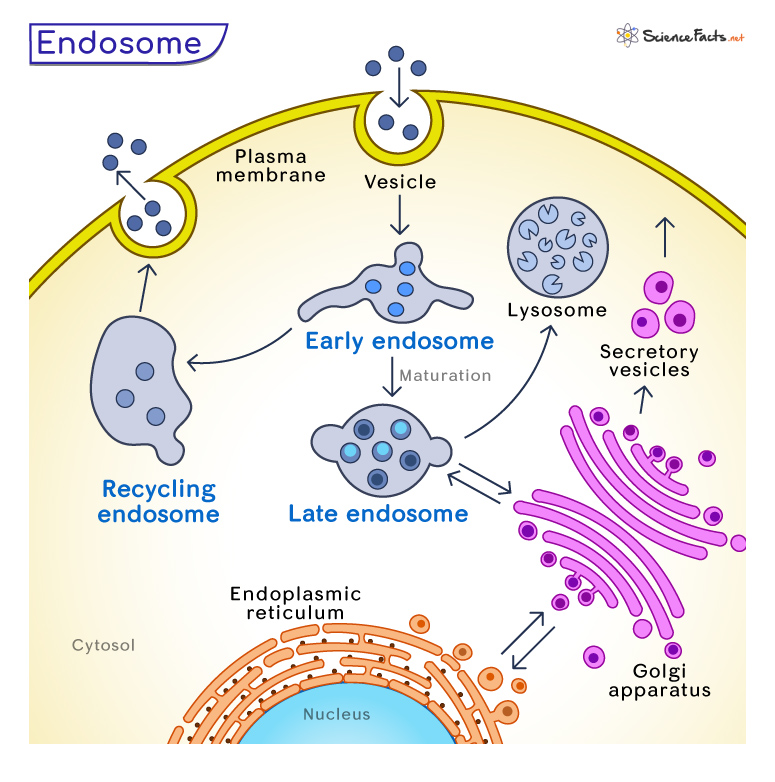Being an integral part of the endocytic pathway, they also receive proteins internalized by the cell through endocytosis. Endosomes further help to recycle these proteins to the plasma membrane or are sorted for degradation through lysosomes.
Types of Endosomes
Endosome Pathway
Maturation and Recycling of Endosome
Other Functions of Endosomes in a Cell
Endosome and Human Diseases
Endosome vs. Lysosome
Endosomes also receive proteins and lipids synthesized from the rough endoplasmic reticulum and transfer them to the Golgi for sorting at the trans-Golgi network (TGN). This retrograde transport diverts proteins and lipids away from lysosomal degradation and helps in cell signaling.
1. Regulating Cell Surface Receptors
Upon binding to the ligand, the extracellular domain of the transmembrane receptor enters the endosomal pathway. The ligand-receptor complex is assembled on specific clathrin-coated sites of the plasma membrane. These regions invaginate and engulf the receptor-ligand complex, which then buds off the plasma membrane to form clathrin-coated vesicles (clathrin-mediated endocytosis). The clathrin-coated vesicles fuse with early endosomes, where the internalized receptor-ligand complex is sorted. The endosome-mediated degradation of the internalized substance marks the end of the receptor-mediated signaling event. Recycling the receptor to the plasma membrane causes the pathway to continue.
2. Uptake of Nutrients
The cell also takes up nutrients following the same process of receptor-mediated endocytosis. The cholesterol uptake occurs through the low-density lipoprotein (LDL) receptor in the clathrin-coated sites of the plasma membrane. The LDL receptor detaches from its ligand during internalization and fusion to early endosomes. It is recycled back to the plasma membrane. The LDL moves towards lysosomes, where they fuse, leading to the degradation of LDL and the release of cholesterol for cellular use.
3. Clathrin-Independent Endocytosis
Other than clathrin-mediated endocytosis, some membrane proteins and extracellular fluids internalize through specific vesicles called caveolae. These vesicles are made of caveolin protein and are internalized and sorted following the same process as receptor-mediated endocytosis.
4. Transmission of Nerve Impulse
During transmission of a nerve impulse and upon generation of the action potential, presynaptic vesicles fuse with the plasma membrane, releasing neurotransmitters and transmitting signals to the postsynaptic neurons. The postsynaptic vesicles are then removed from the plasma membrane through endocytosis, which is then taken up by the endosomes. Within the endosome, regeneration of the synaptic vesicle takes place. Finally, newly formed synaptic vesicles containing neurotransmitters are recycled back to the plasma membrane. In patients with high blood cholesterol, the LDL receptor has two mutations and thus cannot perform endocytosis. One of the mutations prevents the binding of LDL with its receptor, and the other stops the accumulation of LDL receptors in the clathrin-coated pits. Thus, the receptor complex cannot be internalized for processing. In patients who have Alzheimer’s disease, endosomal dysfunction is associated with neurodegenerative disorders.
Similarities
Both are:
Membrane-bound vesiclesInvolved in cell functioningProduced from Golgi apparatusInvolved in endocytosis
